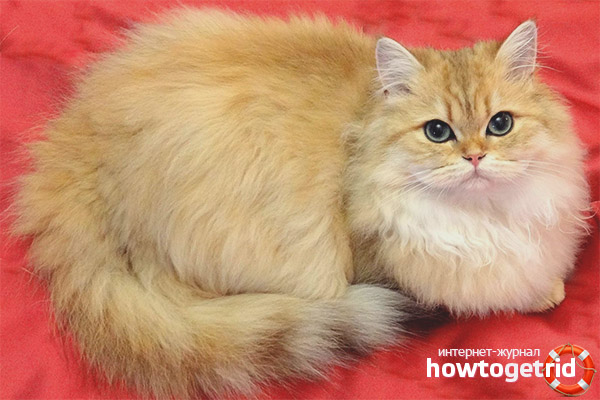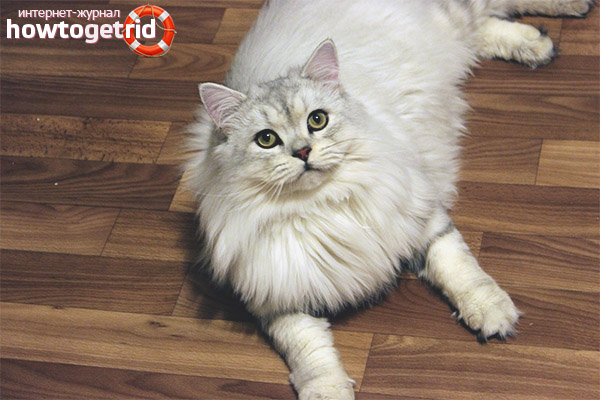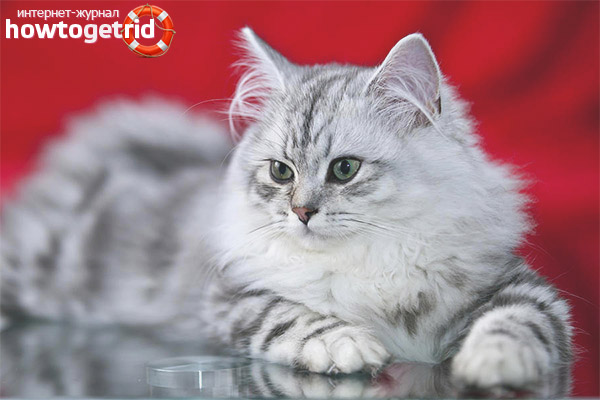The content of the article
Today this breed is very popular with modern man. Now having such a pet at home is considered even fashionable and prestigious. This is due not only to the cute appearance of cats of this breed and good character, but also to the fact that in terms of care and maintenance, such cats are very unpretentious, which is quite convenient.
Breed history
In the early 20th century, they began to produce a variety of experiments, trying to bring out new, distinctive from the previous, breeds of cats. So, by crossing short-haired British cats with Persians, the scientists intended to create the perfect look. It is for this reason that many breeds of cats crossed in those times with the Persians, as they were considered the most noble breed.
But the results were not at all pleasing, but, on the contrary, brought only disappointments.The fact is that the resulting appearance of the new species was not something far from ideal, but on the contrary, it was something terrible. The asymmetric structure of the jaw and skull, hard wool - all this scared away.
So, an important decision was made to keep the Persians in their previous form, but some of the most successful individuals were abandoned and later spread to all corners of the planet. British longhaired or highlanders became their names.
What are the British longhair
- The body of this type of cats is very massive and muscular with broad shoulders and a strong back and neck. The tail is not very long and thick with a slight rounding at the end. Paws in animals of this species are short and strong.
- The structure of the head of these cats is very large. The skull is round. The chin is powerful, and the cheeks are quite plump. The nose is small, straight. The uniqueness of the British appearance lies in the whisker pads - they are very massive.
- The eyes of this type of cats are very large, which gives expression to the muzzle. Eye color is interesting to combine with the color of the animal.
- The ears of these cats are medium and located at a far distance from each other. They have the correct average shape.
Another feature of this breed is the presence of a fluffy tail. As for wool, these cats have a long one, which, incidentally, distinguishes British longhair from their brothers.
Cat colors
In most cases, animals of this breed have a single color of different colors without admixture of any patterns and marks, but, like the representatives of short-haired, they have any color recognized as the standard. However, there are other varieties.
- Tortoiseshell color. In this type of color goes smooth patterns throughout the body. These can be red and black spots, as well as a combination of blue and cream colors.
- Smoky color. Cats that can be found with this type of color are also known as chinchilla or smoke. The main unique feature of this species is the presence of a snow-white undercoat, which covers the main color. It looks very beautiful and original. Cats with this type of color have a darker head, back and legs, but their ears and collar, on the contrary - are lighter (silver).
- Tabby (tabby). They are also called spotty or marble cats. The main and most distinctive feature of these cats is the amazing pattern on the forehead in the shape of the letter M. The color of the spots and the main color are different in color, which makes the drawing original and not like the others. Also on the face there are solid lines that originate from the corners of the eyes and go along the back, drawing a butterfly, as it were. On the neck and chest you can see the rings, which also differ in color from the main color of the cat. There are also peculiar circles on the legs and thighs, and spots on the stomach.
- Bicolor As the name implies, these are species that combine two colors - primary and secondary (for example, tortoise). Here, everything is quite interesting, since the main color of the cat should be more than half of the whole body, and the colored part of the coat should have a clear defined color and strictly defined lines. The following additional condition is mandatory color of one ear, as well as the presence of spots or other marks on the head, face. There should also be a few spots on the legs and back.
- Color point. Color color. It is also called Siamese.It is a pure white color that extends to the whole body. On the face is something like a mask, and the ears, tail and feet are painted in a darker tone than the rest of the wool.
The nature and behavior of the cat
At an early age, kittens of this breed are very active and show themselves immediately. They love to jump and run, hang on the curtains, climb into the box with clothes, in the shoebox and much more. Starting a pet British longhair breed, the owners should take into account the curiosity of cats. And for the period of early development hide everything valuable away.
There is a very big plus: kittens are accustomed to the tray very early and behave very carefully.
An adult individual of this breed is a balanced animal that is not so easy to bring to the emotions. But, if someone still succeeds in doing this, then be sure that the animal harbors a very strong offense and, possibly, will take revenge on the abuser at any convenient opportunity.
With other species begins to make friends pretty quickly. It responds calmly to travels, which allows you to make travels without any problems.And unlike the oriental breed of cats, it is not at all scary to leave the animal alone and without attention. It does not like excessive caresses and touches. The best option for him would be just to be close to the owners, sitting at a distance from them.
Nutrition
If we talk about the diet, then it is worth thinking about it from the earliest times, but if the kitten is already accustomed to a certain type of food, then it is not worth replacing it.
There are special ready-made balanced foods for this type of cat, and that everything that is needed for the animal's body is there. These minerals support the health of the cat in excellent condition.
If the owners prefer to feed the cats homemade food, then you need to remember that pork, as well as the tubular bones of poultry and fish should be excluded from the diet for good, and kittens should not be eaten legumes and potatoes.
It is important to know! If you feed the cat constantly salty, fried or sweet, then soon the metabolism will be broken, which will lead to a deterioration of the animal's condition.
What is feed your pet? To permitted foods include boiled chicken, beef, as well as raw quail eggs.Kittens are very fond of dairy products and are happy to enjoy them. And, if you still decided to feed your pet with homemade dishes, then from time to time add to the diet all kinds of supplements in the form of vitamins and minerals.
Care
Many owners note the fact that this breed is not picky in terms of care. This greatly simplifies the life of the owners.
- You need to comb them quite often. You can use a special rubber mitten for this.
- When the period of molting begins (spring and summer), it is important for the owners to give the pet special medicines that promote the rapid removal of hair from the pet's body, but if you still have problems with your health, contact a specialized veterinary clinic as soon as possible.
- When hygienic bathing procedures, it is important to use special shampoos for cats of long-haired breeds.
Breed health
This breed of cats is characterized by endurance and good health, but, like any other species, there are a number of diseases inherent only in them.
- First, it is the presence of parasites in the body of cats.You can prevent this from an early age by producing preventive procedures against ear mites, worms and much more. Treatment should only occur under the supervision of a veterinarian. And it is important to remember that the process of getting rid of worms and parasites is contraindicated for pregnant and weakened cats.
- Diarrhea can also occur with improper diet and impaired metabolism, so the choice of food should be approached very carefully. It is not necessary to feed the animal only with meat and milk, as well as to feed spoiled or expired products. A long trip by car or train can also cause intestinal upset, a variety of excitement associated, for example, with the appearance of a new animal in the area.
- Hair loss is another unpleasant thing that accompanies this breed. It can provoke things like pregnancy, molting, worms, the presence of constant stress, gastrointestinal upset and much more. To find out the reason why the animal began to drastically lose its coat, you should visit the vet as soon as possible.
- Pets of this breed are very fond of licking wool, because of which lumps in quite large quantities accumulate in the stomach.This can lead to disruptions in the digestive system and even lead to surgery.
Breed cost
To date, the cost of kittens of highlanders of this breed depends on many circumstances: pedigree, fame of the institution, what sex of the pet, and much more. It is a rule that cats are always more expensive than cats at a cost. Now the price ranges from 500 to 1500 dollars. By acquiring such a pet for yourself, you together with it acquire extraordinary calm, comfort and warmth, dedication, which the animal will gladly give you.
Video: British Longhair














To send